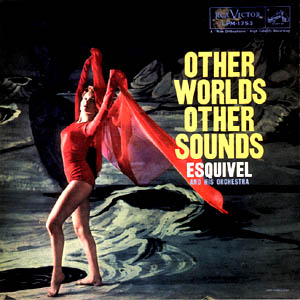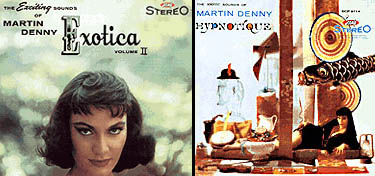|
Exotica
The longing for the ideal, the island and a dreamland: Exotica.
Beyond the horizon of the setting sun, where one can feel close to nature and the savage is always noble in the imagination. Everything is slightly dangerous, mysterious but the primative world stays like the erotic undertones at a safe distance, so that it is slightly arousing. 1948 James A Michener wrote his book Tales of the South Pacific, which Rogers and Hammerstein turned into a successful musical and later in 1958 went on to become a movie hit.
During the 2nd World War, the controversial South Pacific Polynesia was in the conscience of the American public a bloody battlefield but the place of acquatic fights was suddenly changed to become the prototype of the idyll. It was soon replaced by Hawaii as a sort of domesticised version of the distant (in 19th century Germany Tahiti played this role). Traditionally this image of the idyll was jazzed up by Latin American influences. Exotica became the musical expression of the longing to travel and for the foreign and unknown. Popular and folklore interpretations from all over the world, strange sounds and rhythms, unusual orchestral combinations, these were the ingredients of this particular mixture, that was aware of its own artificiality and at the best possible moments able to play around with these elements. The goal was not authenticity. Exotica is in some manner the most honest and straight forward kind of music since it is so selfconfidently fake. (Stuart Sweezy, Exotica - Häfen der Lustbarkeit)

Martin Denny - born on April 5, 1911 in New York, grew up in Los Angeles, toured many years through South America with the Don Dean Orchestra, played in various other orchestras (for example Gigi Gryce), accompanied artists like Betty Hutton, was during the 2nd World War with the US Air Force in Germany and France. He visited the conservatory in LA after the war, where he concentrated on composition and piano. He has lived in Hawaii since 1954. He founded his own band in 1955, published 37 records, the most recent recordings were released in Japan in 1990. The special Martin Denny sound was created by a special mixture of piano, vibra - and marimbaphone, accustic bass and a selection of percussion instruments from all over the world.
Every member of his band mastered more than one instrument and Denny understood how to create an unmistakeable hybrid in his music, a perfect mixture of melodies with Latin American influenced rhythms and seemingly exotic sounds. His often imitated trademark was the addition of animal sounds integrated into his arrangements giving the music an almost surrealistic touch.It came about rather by chance. In 1956 we played in the Shell Bar, a part of the Hawaiian Village (a segment of an amusement park in Honolulu). The room where we played had a very exotic ambience, next to the stage was a small pond, cliff, palms - very tropical, very relaxed. One evening we were playing a certain tune and the frogs began to croak (with a deep sound) rivet! rivet! When we stopped playing the frogs stopped too. When we played the song again later the frogs started again and some of the band members spontaneously started to imitate bird calls. This arrangement was requested time and again and finally became his biggest success. It was called Quiet Village and became the exotica hymn of all time. We played at ‘Don the Beachcomber's’ on the beach of Waikiki and many of the soldiers stationed on Hawaii heard us and bought our records. When they were transfered, they took those records with them and played them for others. The name became famous through word of mouth: The Exotic Sounds of Martin Denny. The S.S. Nautilus was the first American submarine to cross the North Pole. They had Quiet Village in their jukebox and after their expedition, they wrote me that this was their favorite tune.
Until recent years, Martin Denny was still musically active, in the meantime he commits himself to his hobbies: golf and collecting exotic musical instruments.
Les Baxter - It was the success of Quiet Village that made it possible for Martin Denny to popularize exotica. But someone else had composed this piece - Les Baxter. Quiet Village had already been released several years earlier on Baxter's record Ritual of the Savage, an Exotica classic way before this expression was known. Les Baxter was in high demand as an arranger, for example for Nat King Cole; his special feeling for the combination of exceptional sounds gave his compositions their own character. He composed alot for film and even for films that never came out, like The Sacred Idol. In addition, in 1950 he helped another exotica star to get off to a successful start by producing Yma Sumac's Voice of the Xtaby.
Yma Sumac
Many legends are entwined with the singer Yma Sumac. In the 50´s she was promoted as an Inka princess, in the 60´s they tried to make her an American housewife named Amy Camus, but in general her identity remained a mystery. Yma Sumac was born in the 20's in Peru as Zoila Augusta Emperatriz Chivarra del Castillo, her stage name came from her mother. In the 40's she married Moises Vivanco who later was responsible for many of the arrangements and compositions on her records. She owed her first big success to Les Baxter, who produced and arranged her album "Voice of the Xtaby", the only full length album that was never removed from the catalogues and was rereleased time and again. Yma Sumas's legendary voice covered 5 octaves and she influenced uncountable singers from Nina Hagen to Diamanda Galas. She could consequently use her voice as an instrument and was the living role model of the perfect exotica goddess. She still gave concerts until the early 90´s.
|

